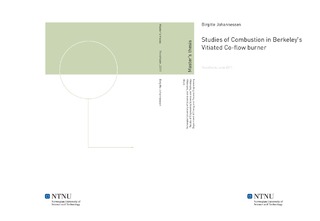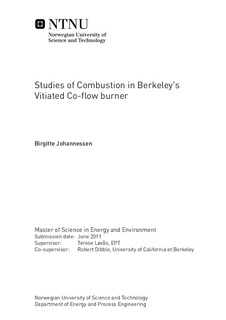| dc.contributor.advisor | Løvås, Terese | nb_NO |
| dc.contributor.advisor | Dibble, Robert | nb_NO |
| dc.contributor.author | Johannessen, Birgitte | nb_NO |
| dc.date.accessioned | 2014-12-19T13:52:55Z | |
| dc.date.available | 2014-12-19T13:52:55Z | |
| dc.date.created | 2011-10-20 | nb_NO |
| dc.date.issued | 2011 | nb_NO |
| dc.identifier | 450291 | nb_NO |
| dc.identifier | ntnudaim:6714 | nb_NO |
| dc.identifier.uri | http://hdl.handle.net/11250/257154 | |
| dc.description.abstract | An experimental investigation is presented of unsteady N2-H2 jet flames in a co-flow of hot combustion products of lean premixed hydrogen combustion. The unsteady jet flame is characterized by rapid ignition followed by a gradually blowout of the flame. Audio recordings and Schlieren imaging high speed videos are used to investigate the unsteady flame. The frequency of the blowout-re-ignition event is investigated as a function of nitrogen dilution mole fraction (YN2=0.180-0.566), co-flow equivalence ratio (Phi=0.20-0.27) and jet velocity (Vjet=300-500 m/s). The results from the audio recordings and Schlieren imaging high speed videos indicate that re-ignition of the flame occurs as a result of autoignition. The ignition frequency increases with increasing nitrogen dilution mole fraction until a maximum frequency is reached of about 20-27 Hz. After the maximum frequency is reached the frequency decreases with a further increase of the nitrogen dilution mole fraction until the flame is completely blown out. By increasing the co-flow equivalence ratio the flame becomes unsteady and blown out at increasing nitrogen dilution mole fractions. The range of nitrogen dilution mole fractions over which the flame is unsteady is decreasing with increasing co-flow equivalence ratio. By increasing the jet velocity the flame with low co-flow equivalence ratios (Phi=0.20-0.22) becomes unsteady and blown out for decreasing nitrogen dilution mole fractions. For higher co-flow equivalence ratios (Phi=0.24-0.27) the range of nitrogen dilution mole fractions over which the flame is unsteady increases with increasing velocity. An increase in the velocity at higher co-flow equivalence ratios leads to an unsteady flame for lower nitrogen dilution mole fractions and a blown out flame for higher nitrogen dilution mole fractions. These results suggests that the autoignition phenomena of the N2-H2 jet flame issued into a vitiated co-flow is controlled by both chemistry and turbulent mixing. The results from the audio recordings and the Schlieren imaging high speed videos correspond well. This gives confidence to using audio recordings as a method of diagnostics of unsteady hydrogen jet flames. | nb_NO |
| dc.language | eng | nb_NO |
| dc.publisher | Institutt for energi- og prosessteknikk | nb_NO |
| dc.subject | ntnudaim:6714 | no_NO |
| dc.subject | MTENERG energi og miljø | no_NO |
| dc.subject | Varme- og energiprosesser | no_NO |
| dc.title | Studies of Combustion in Berkeley's Vitiated Co-flow burner | nb_NO |
| dc.type | Master thesis | nb_NO |
| dc.source.pagenumber | 130 | nb_NO |
| dc.contributor.department | Norges teknisk-naturvitenskapelige universitet, Fakultet for informasjonsteknologi, matematikk og elektroteknikk, Institutt for elkraftteknikk | nb_NO |

